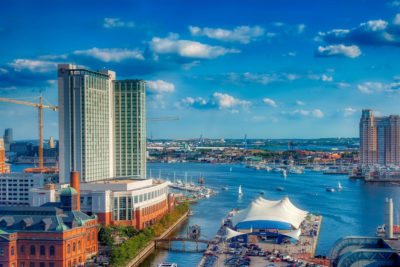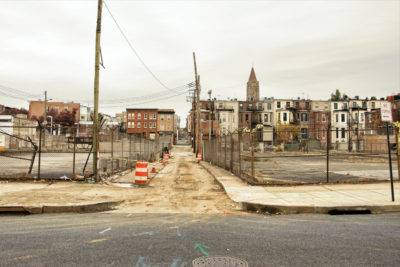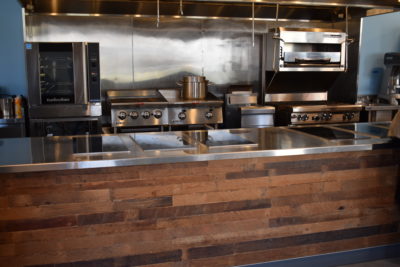
“Good morning Baltimore,” I sang to myself as my train pulled into the Camden MARC station. I was greeted by the famous warehouse that stands between the train station and Oriole Park at Camden Yards – a familiar haunt of mine from time as a student at the University of Maryland. I was excited to be back in Baltimore. I walked toward the Inner Harbor, the main tourist, business, and retail hub of the city. As I passed a half-occupied shopping center, I took in the beauty and solitude of the harbor on a quiet spring morning. I walked along the south shore toward my destination, the American Visionary Art Museum.
Although it is one of my favorite museums in the country, I wasn’t there for the art. Instead, I was there to attend the spring convening of the Retail Opportunity Network, a collection of more than 70 organizations developing ways to make it easier for frontline retail workers to advance in their careers. The convening started with site visits to two Baltimore retail businesses. I grabbed a seat on the bus.
Redline redevelopment
Between our departure from the museum to the first stop at Humanim social enterprise City Seeds, we were given a driving tour of the downtown area of Baltimore. Our tour guide, Dan Taylor of the Baltimore Development Corporation, provided commentary. One of our first points of interest was Harbor East. Like much of the area surrounding the Inner Harbor, Harbor East used to be warehouses for Baltimore’s industrial giants, before they all left. With encouragement and support from the city, local investors took over the now-abandoned properties and built a new neighborhood from the ground up. The only thing missing were new residents.
We learned from Dan that while the Inner Harbor may be the main economic and tourist hub of the city, few residents lived there. In fact, unless your job was located in the Inner Harbor, as a Baltimore resident, you had no real reason to travel to that part of the city. The harbor’s developers needed to find something that would bring people to live there.
Enter Whole Foods. Lured by the offer of free rent for a decade, Whole Foods took a chance on the neighborhood. It worked. People began flocking to Harbor East and more amenities began popping up —restaurants, shops, a movie theater. Now, Harbor East serves as a major destination for residents and visitors alike.

As we continued our drive, Dan described Baltimore as a “block by block” city divided into dozens of small neighborhoods. The discussion turned toward Baltimore’s notorious history of redlining as a way to segregate the city. Even though the practice has been illegal for decades, the scars remain. Passing through the city, you’ll see well-kept buildings, restaurants, and shops on one side of the street while the other side would be nearly abandoned and in disrepair.
The city is now trying to heal the scars. While repairing the damage of redlining is certainly an important effort, it doesn’t always end up benefiting those most adversely affected by redlining.
Take East Baltimore, for example. East Baltimore’s redevelopment is well underway. Its proximity to Johns Hopkins Hospital made it a priority area for redevelopment. With plans to create and maintain a racially and economically diverse neighborhood, the East Baltimore Development Initiative began in 2003. New buildings went up, new schools opened, and retail space was added. Historical landmarks, like the Northeast Market, one of Baltimore’s oldest public markets, and its surrounding area, were given facelifts to reinvigorate the area. All this growth has been a boon for the newly redeveloped neighborhood and its new residents. But this project was not without its headaches.
To rebuild the neighborhood from the ground up, the residents of East Baltimore were forced from their homes. The original residents are just now starting to trickle back, after more than a decade. Some may never come back. The neighborhood is fundamentally changed, and at the expense of the very residents hurt by redlining.
With East Baltimore nearing completion, the city and developers have turned their attention to Perkins Homes, which has multiple Section 8 housing projects for low-income residents. City leaders are hoping to avoid the issues created in East Baltimore. To ensure that the displacement of residents is minimal, they are redeveloping building by building, rather than razing whole blocks and displacing residents for years at a time.
As we pulled into our first stop at City Seeds, a social enterprise providing people with an opportunity to learn about the catering and foodservice industry, I looked around but there was nothing here. In Baltimore, neighborhoods grew where the jobs were. When manufacturing and other jobs left, neighborhoods followed. This hit redlined neighborhoods especially hard, exacerbating already existing challenges. I found it astounding that City Seeds would set up a catering and training facility in a mostly barren area.

But the work being undertaken by City Seeds is beneficial not only to the local area but the people they serve. City Seeds focuses their hiring on individuals with barriers to employment. These folks are in need of a new chance at a career. By providing a real-world kitchen experience to people interested in entering the catering or restaurant business, City Seeds is creating new opportunity to a neighborhood that needs it. Enterprises, like City Seeds, that are operating in near-abandoned areas are providing the first step in neighborhood revitalization – good jobs and opportunity.
On the way to our next stop, we had a new tour guide, Michael Pokorny of the Reinvestment Fund. As we headed to Ace Hardware in Federal Hill, an upscale neighborhood just south of the Inner Harbor, Michael pointed out many of the Reinvestment Fund’s city revitalization projects. One project involved courting a grocery store to open in a redeveloping area to provide essential services for residents. I noted that this was the second time today that grocery stores were brought up as an explicit tool in major redevelopment projects.
Grocery stores as neighborhood anchors
What does a grocery store provide for a community? First and foremost, grocery stores provide communities with a hub for food: fresh produce and grocery staples, butcher counters, fishmongers, delis, and bakeries. But grocery stores provide more than just food. Some have banks, coffee shops, pharmacies, florists, and other non-food related services. Big box grocery stores like Walmart, Costco, and Target offer a one-stop shop for almost any need you could have. I like to say to myself, “If Costco doesn’t sell it, it doesn’t exist and isn’t worth buying.”
But grocery stores also provide opportunity. Grocery stores are massive operations, requiring dozens of employees across multiple departments and functions. On a given Saturday morning when my fiancée and I go grocery shopping, we see anywhere from 10 to 15 employees across a variety of departments. And these are just the visible employees. We don’t see the staff in the back who unload trucks, prepare food, or track inventory.
Who exactly are the workers in your local grocery store? They’re your neighbors. They’re members of your community who are working to provide for themselves and their families. Their hard work makes your community a desirable place to be. You have convenient access to fresh produce, quality meat, grocery staples, and other services. Take a minute and really think of how vital your grocery store is to your everyday well-being. Your grocery store truly is an anchor for your community.
But, what if grocery stores did more than make an area desirable? What if grocery stores were at the forefront of improving the lives of individuals in redeveloping neighborhoods?
DMG Foods is doing just that. DMG is a non-profit grocery store operated by the Salvation Army that is testing new ways to provide opportunity to residents in their community. As a non-profit, DMG is able to keep costs low, allowing low-income families to afford fresh produce and quality meats. This creates a healthier population, which in turn creates a healthier community.
 But DMG is doing more than keeping prices low. They are investing in the careers of local residents. DMG is providing their employees an opportunity to grow the skills they need to succeed not only in grocery retail but in any work environment. DMG’s hiring strategy targets workers with extensive gaps in their work history. By investing in workers’ who are often left out of work opportunities, DMG improving the economic well-being of not only their employees but their community as a whole.
But DMG is doing more than keeping prices low. They are investing in the careers of local residents. DMG is providing their employees an opportunity to grow the skills they need to succeed not only in grocery retail but in any work environment. DMG’s hiring strategy targets workers with extensive gaps in their work history. By investing in workers’ who are often left out of work opportunities, DMG improving the economic well-being of not only their employees but their community as a whole.
Of course, this model is not without challenges. Training new staff is a challenge for any business, but when your staff is primarily comprised of workers with employment gaps and little professional experience, that challenge grows. Training time is longer, but, they understand that their employees sometimes need an extra touch. By understanding the challenges their workers struggle with, DMG is able to provide a supportive culture that allows their employees to gain the skills they need to succeed.
DMG is looking to expand to 10 stores across Baltimore. They have an opportunity to be an anchor for many redeveloping neighborhoods across the city, such as Perkins Homes. Their affordable groceries will support low-income residents, and their innovative hiring strategy will provide entry into the labor market for many Baltimore residents desperate for another chance at a career.
What can we do?
As we arrived back at the museum for the second half of the day, I thought about the main topics of the RON convening in light of what I’d seen that morning.
Equity. Baltimore has a long history of systemic racial inequity. We saw the scars of redlining. We learned about the unintended consequences of indiscriminate redevelopment and the steps being taken now to prevent the mistakes of the past. There’s a lot to be done to address structural issues still plaguing the city, but slowly, the city is approaching these issues with an eye toward equity.
Employer Engagement. DMG Foods showed us that employers can be leaders in breaking down barriers. They are taking a chance on some of the most vulnerable residents of Baltimore, giving them an opportunity to succeed. Employers can be at the forefront, innovating and making change for their communities.
Future of Work. We don’t know how long this tight labor market will last. One thing we do know is that people need to eat. Grocery stores provide an essential service to their communities. Grocery stores that are out in front, investing in their communities, are positioning themselves to succeed today and in the future.
Grocery stores were not a scheduled stop on my tour bus. There were no presentations at the RON convening itself from grocery store representatives. (I learned about DMG and their model from my associate Kanny Morgan, who was part of the National Fund team that attended the RON. She was on the other tour bus that morning, which made stops at Bicycle Works and DMG Foods.) But I learned that grocery stores play an enormous role in anchoring and solidifying the growth and health of neighborhoods and their residents.
The theme for the 2019 RON Spring Convening was “Fusing the Future of RON: Critical Themes for Advancing Our Work.” This event provided us an opportunity to rethink many of our preconceived notions about the role retail plays in our society. We are doing that at the National Fund, as we continue to focus our retail work on innovative and new strategies to raise up frontline workers. Working with the RON and its members, we are piloting new and innovative strategies to improve retail occupations and create pathways to success for entry-level frontline workers. Seeing the impact grocery stores can have on growing and redeveloped neighborhoods only reinforces the importance of the work being undertaken by the National Fund and RON.
About Retail Opportunity Network
The National Fund for Workforce Solutions is a member of the Retail Opportunity Network, a collection of over 70 organizations working collaboratively to drive system change for the U.S. retail sector. Through their work, collective learnings, and knowledge sharing, network members are developing more efficient and innovative ways to advance the careers of frontline retail workers.



